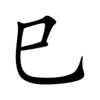巳
| ||||||||
Translingual
| Stroke order | |||
|---|---|---|---|
 | |||
Han character
巳 (radical 49, 己+0, 3 strokes, cangjie input 口山 (RU), four-corner 77717, composition ⿺乚コ)
References
- KangXi: page 326, character 12
- Dai Kanwa Jiten: character 8744
- Dae Jaweon: page 631, character 1
- Hanyu Da Zidian: volume 2, page 984, character 2
- Unihan data for U+5DF3
Chinese
| simp. and trad. |
巳 | |
|---|---|---|
Glyph origin
| Historical forms of the character 巳 |
|---|
| Shuowen Jiezi (compiled in Han) |
| Small seal script |
 |
| Characters in the same phonetic series (巳) (Zhengzhang, 2003) | |
|---|---|
| Old Chinese | |
| 巳 | *ljɯʔ, *lɯs |
| 祀 | *ljɯʔ |
| 汜 | *ljɯʔ |
| 戺 | *zrɯʔ |
| 起 | *kʰɯʔ |
| 熙 | *qʰlɯ |
| 媐 | *qʰlɯ, *lɯ |
| 圯 | *lɯ |
| 异 | *lɯ, *lɯs |
| 巸 | *lɯ |
Different theories:
Etymology 1
Pronunciation
References
- (Min Nan) “Entry #210”, in 臺灣閩南語常用詞辭典 [Dictionary of Frequently-Used Taiwan Minnan] (in Chinese and Min Nan), Ministry of Education, R.O.C., 2011.
Japanese
Korean
Hanja
巳 • (sa) (hangeul 사, revised sa, McCune–Reischauer sa, Yale sa)
- the hours from 9 to 11
- 6th terrestrial branch
Vietnamese
Han character
巳 (tị)
- This term needs a translation to English. Please help out and add a translation, then remove the text
{{rfdef}}.
This article is issued from
Wiktionary.
The text is licensed under Creative
Commons - Attribution - Sharealike.
Additional terms may apply for the media files.